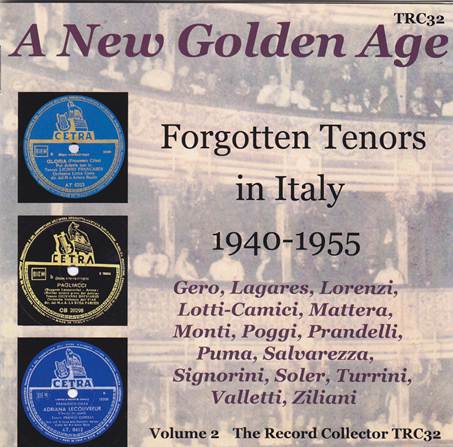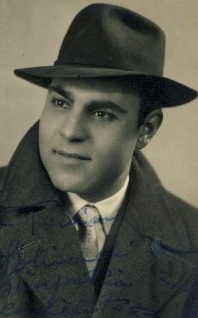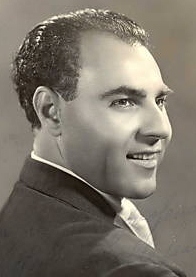FORGOTTEN TENORS IN ITALY 1940-1955 VOLUME TWO
The Record Collector TRC 32
(website see links)

A NEW GOLDEN AGE
FORGOTTEN TENORS IN ITALY 1940-1955 VOLUME TWO
The Record Collector TRC 32
(website see links)

Forgotten tenors ? I wouldn’t exactly call Poggi, Prandelli, Valetti forgotten as is proven by the dozens of pages on Google with their names. Why are they included nevertheless ? Probably for the reason that the real thread behind this issue, tenor buff Alan Bilgora, had run out of really rare records by rare Italian tenors or tenors singing in Italy and therefore included them in his selection. Another reason may be that “splendid isolation” is still a frame of mind with older Britons. They are somewhat closed to the rest of the world (witness the returning reviews in The Record Collector of the same records by the same historic singers time and again; only the labels differ). But in the wider world outside that tiny little isle some collectors will grumble and some may even decide not to buy this interesting album as they already have the reissues of many shellac recordings on Italy’s Bongiovanni or on Austria’s Preiser ( Poggi and Prandelli), Or they still take a look at their LPs and MPs where they can easily find Salvarezza, Soler and Turrini. The internet too now plays a major lot as private collectors put their rare records on CD-R and distribute them among friends who in their turn exchange them for other rarities. The very rare original Rafael Lagares items are widely available among tenor collectors in the form of a CD-R. It has however to be said that not everybody has the knowledge to produce transfers in the correct pitch as is to be found on these two CD’s. I have only one question mark. The voice on track 4 (tenor Costanzo Gero singing the Siciliana) is different from the same voice on track 1 – 3. It sounds far brighter and I for one cannot believe that Gero’s voice changed so much in 24 hours time as track 3 was recorded one day earlier.
I’m somewhat surprised Mr. Bilgora in his sleeve notes compares Gero with Tagliavini. The voice is far drier, has in “Quanto e bello” nothing of the honey Tagliavini always generously provided and indeed shows a lot of semblance with Schipa. Gero has a somewhat higher voice so that he didn’t have to transpose like the tenor from Lecce often did and Gero’s agility is good for the time (better than Tagliavini’s clumsiness in”Ecco ridente”) though he is not Florez. The Gero tracks are not doubling the items by the same tenor on Pearl’s The Cetra Tenors Album (no doubt known by Mr. Bilgora as it is an English label). The Lagares records show a robust spinto voice; darker than the usual Italian tenor; more in the Spanish Fleta-Domingo sound. Impressive is the tackling by Lagares in the Addio alla Madre section of the “s’io” on which he opens up. Few tenors can do it so splendidly. I can understand that in an album like this only arias from Italian operas (or operas translated in Italian) find their place but I hope that one day even the more impressive zarzuela recordings by the Argentinean tenor will appear. Remarkable is the fine Micaela in the Carmen duet: the almost forgotten Rosanna Papagni (otherwise only known for a small bit part in Zandonai’s Il Bacio). The name of Ermanno Lorenzi is better known today though his fame rests firmly upon a widely distributed Butterfly-duet with the magnificent Sena Jurinac and some roles as a comprimario. One easily understands why he had to resort to smaller parts. The voice shows warmth, combining it with a strong cutting edge. The fly in the ointment is the unremitting forte in arias that cry out for nuance like “M’appari” and “Cielo e mar”. The instrument is fine but one indeed has the feeling that singing of this kind will not last for very long. The two pieces by Alberto Litti-Camici reveal a lovely leggiero much in the ways of better known singers like Giovanni Manuritta, Luigi Fort or Roberto D’Alessio. Lotti’s is one of the few recordings of an aria from Mascagni’s unjustly forgotten Silvano. With Gino Mattera we get the exemplary Italian tenor we now sorely miss in most opera theatres. Not the most outstanding voice but his three arias reveal a bright, good and solid though a bit dry voice. The astonishing amount of such Italian tenors for whom singing was one of the few jobs to make a decent living in a poor country automatically guaranteed that a few singers of genius would rise from the ranks. When Italy became just another European country the breed disappeared and so did the really great tenors. Nicola Monti (due to the Callas-Sonnambula recording) is still more than just a name and his Nemorino in the complete Elisir d’Amore with Carosio and Gobbi is a charming fellow indeed. This recording predates the complete issue with one year and I for one was somewhat surprised by the tear in the voice, by the slightly chopping up of phrases to make an effect. In L’Arlesiana the emotion is in its place and this recording is easily the finest Italian one (after Tagliavini) of the aria.
With young Gianni Poggi the feeling is always double. It bears comparison with the way one listens to the earliest recordings of Giuseppe Di Stefano. One hears a wonderful natural voice but with the advantage of hindsight one cannot refrain from hearing the start of the faults which from the mid fifties on would mar much of their singing; in Poggi’s case a pumping of sound and a beginning of whining though in these recordings the sound is lyrical, richly coloured and with splendid top notes. The interpretation is something else: a shameless copy with sobs and everything else included of Gigli’s 1934 recording of “E lucevan le stelle”. I wonder why Mr. Bilgora in his track list only mentions “O dolci mani” while in reality the music includes the whole of the duet “Amaro sol per te” as well. And why doesn’t he mention the fine dramatic soprano singing with Poggi ? (Adriana Guerrini). With Giacinto Prandelli and his fresh and stylish singing we are well acquainted from other reissues. Important are the four arias by Salvatore Puma. This singer was duly considered a competitor of young Franco Corelli.

 Salvatore Puma, collection of the editor)
Salvatore Puma, collection of the editor)
There is the nice (in my opinion) vibrato and the warmth and attractiveness of the big voice, so sadly under recorded as most collectors will only know Puma by the Olivero-Iris though there are such rarities as a Puma- Don Carlo to be found as well ( by Verdi’s contemporary Pasquale Bona), while not forgetting the legendary Bastianini-Tabarro (With the magnificent Nora De Rosa. I hope one day The Record Collector will produce an issue of great underrated Italian sopranos like De Rosa, Novelli, Amedeo, De Osma, De Cecco etc.) The Puma tracks are one of the reasons one has to purchase this album. There is only one aria by Antonio Salvarezza who started out at 35 and still had a good career. Somebody who heard him in Antwerp told me once that together with Vezzani this was the greatest tenor voice he ever heard. “Ch’ella mi creda” is smooth and incisive; sung with ringing top notes. The reason why only this one aria is included here seems to be that the rest of his small output can be found on the Pearl Cetra reissue (and on a Tima-LP). I don’t get the inclusion of two arias by Giovanni Signorini. This is the second rate sound of well known stalwarts as Piero Di Palma, Athos Cesarini and other Italian comprimarii (which is not to say that their voice was small. It often was not but the voice is not very pleasant) and I could have done without these rarities. José Soler is represented once more with Andrea Chénier; firm sure footed singing but maybe it wouldn’t have been a bad idea to use some other arias from the Cetra vaults as he was more than the tenor on the often reissued complete album with Tebaldi. With Roberto Turrini we return once more to the typical Italian spinto: bright and forceful but without the ability to sustain his high notes for more than a second. One hears he simply runs out of breath. Cesare Valletti in his two Mefistofele arias is himself: graciously and stylishly in arias in a league too big for his voice. The album ends with two spirited Butterfly pieces by the only tenor who already made his début in the nineteen twenties: Alessandro Ziliani.
The sleeve notes by Mr. Bilgora are extended though very much in the dreary The Record Collector Style: “and then he sang this and that” “ and then he went to such and such place and sang” etc etc. One understands the method behind it. The author has consulted a lot of chronologies, looked for the tenors’ names and simply jotted down where and what they sang. But we don’t get a real feeling for their career. We are not told what were their best roles, when did the career reached an apex and when did it go down ? And why did that happen. Old age ? Misuse of vocal cords ? The notes thus depend too much on the availability or non-availability of books in the author’s collection. This availability too explains why Poggi gets more than two pages as if he is the most important tenor of them all. Still if one has no problems with tracks one already owns the set is still a must for tenor collectors. Will there be one day a set devoted to other voice categories ? I remember dear old Michael Thomas once commenting on the buyers in his amazing labyrinth in Lymington Road off Finchley Road: “Anyway they buy only tenors.”
Jan Neckers